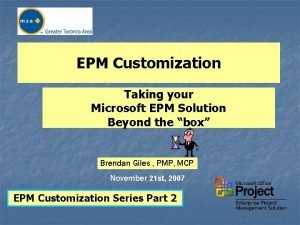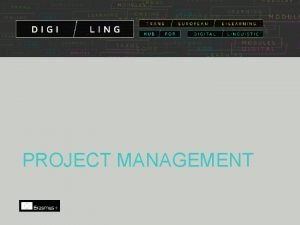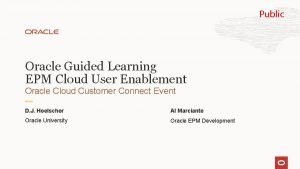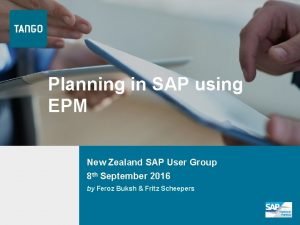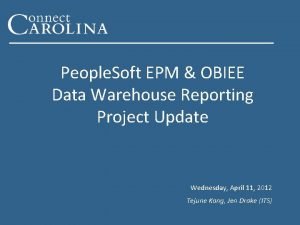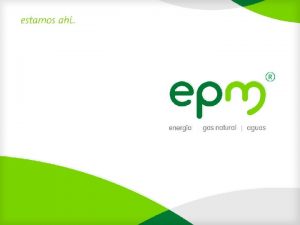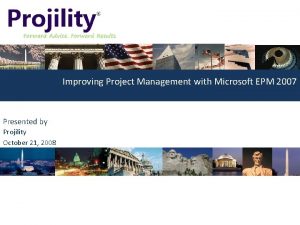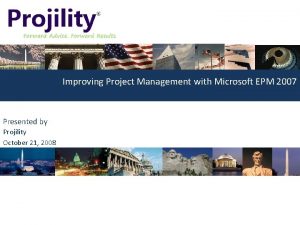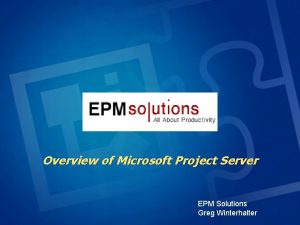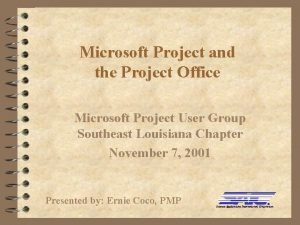Reporting to Management Using Microsoft Project and EPM
















- Slides: 16

Reporting to Management Using Microsoft Project and EPM Derek Loar, Pcubed

Agenda 1. 2. 3. 4. Perspectives in Project Information Types of Information Views (reports) Project Metrics Resource Capacities

Organizational Rollup Portfolio Management Enterprise Resource Management Collaboration and Project Management Alignment with Business Objectives Integrated Delivery Framework Real-time Executive Decision Support Corporate Strategy Programs, Initiatives Investment, Resource and Prioritization Decisions Integrated Portfolio of Managed Projects Consistent, Repeatable Project Delivery Tools, Technology, Training and Knowledge Transfer

Perspectives in Project Information Resource Managers Team Members What resources are available A clear understanding of ownership Project Team Members Managers Resource Managers IT Managers Executive Stakeholders What am supposed to be delivering this week? When will we&to really finish and what will it cost? Who’s available staff our new Can we link project data with ourprojects? front & back office? How can II see prioritize initiatives across my org? IT Open, How Ire-use collaborate with on my team? Exec Who's Stakeholders Cancan we best practices across projects? working on what and do they have the skills? What’s the best way deploy monitor? What’s the status of to our toppeople 3 and initiatives? secure systems Insight and Reporting Project Managers Intuitive project management

Types of Information Views (reports) “Out-of-the-box”: • Project Professional Views (Tables, Filters, Groupings, and Graphics) • Project Professional Reports • Master Projects (for Rollup in MS Project) • Project Web Access Project and Project Center Views • Project Web Access Portfolio Analyzer Views • Project Web Access Resource and Availability Views • Share. Point “Dashboards” –with Project Server Web Parts

Types of Information Views (reports) Other add-on solutions: • Extended OLAP cube (for Portfolio Analyzer) • SQL Reporting Services • Excel Spreadsheets mapped to data • EPK (Enterprise Project Knowledge) • Pro. Sight

Types of Information Views (reports) Explore views

Project Metrics • Schedule – Baseline Variances • Cost – Baseline Variances – Budget Variances • Risk (This metric can be scored per project and managed in Windows Share. Point Services) – Risk level (Impact, Severity, Probability) – Contributors (Complexity, Vague Requirements, Resource Availability, etc. ) • Issues – Open, Overdue, Closed • Change – Multiple Baseline Variances

Project Metrics • Schedule Quality – Tasks without Baseline information – Over-allocation of Resources – Incomplete (Remaining) work in the past – Tasks without Assignment of Resources and/or Work Effort – Physical % Complete does not match Percent Complete (at 0% or 100%) – Actual Hours exist in the future • Health – All of the above can be weighted and combined into an overall score

Example SQL Reporting Services

Example Master Project Schedule Report

Example Master Project Schedule Report

Example Master Project Schedule Report

Example Master Project Schedule Report

Resource Capacities Explore views

Final Thoughts • Defining what metrics and information is important and can be obtained can be very complex across an organization • When creating a solution either based on EPM or MS Project on the desktop, start with a few key metrics and build from there • Senior Stakeholders need to use the data, whether it’s printed for them or the go online to look – By nature, if they don’t use and manage by it, the metrics and reporting will not be maintained
 Microsoft project server reporting
Microsoft project server reporting Microsoft epm
Microsoft epm Microsoft project scrum template
Microsoft project scrum template Servereo
Servereo Traditional project management vs modern project management
Traditional project management vs modern project management Project management financial reporting
Project management financial reporting Microsoft project server resource management
Microsoft project server resource management Microsoft office enterprise project management
Microsoft office enterprise project management Microsoft office enterprise project management
Microsoft office enterprise project management Teléfono de epm
Teléfono de epm Oracle guided learning
Oracle guided learning Sap bps vs bpc
Sap bps vs bpc Epm data warehouse
Epm data warehouse Apa itu epm
Apa itu epm Epicor epm
Epicor epm Teléfono de epm
Teléfono de epm Epm 500
Epm 500

